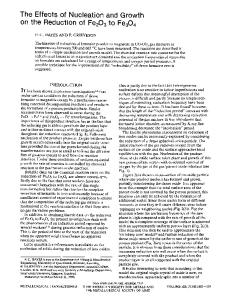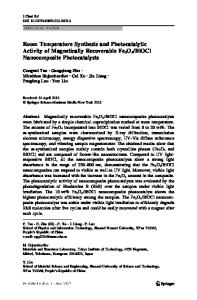Impact of CuO incorporation on the photocatalytic enhancement of the mesostructured Fe 2 O 3 nanocomposite
- PDF / 934,444 Bytes
- 10 Pages / 595.276 x 790.866 pts Page_size
- 22 Downloads / 367 Views
ORIGINAL ARTICLE
Impact of CuO incorporation on the photocatalytic enhancement of the mesostructured Fe2O3 nanocomposite K. S. Al‑Namshah1 Received: 17 August 2020 / Accepted: 21 October 2020 © King Abdulaziz City for Science and Technology 2020
Abstract In this investigation, a nanocomposite made of CuO/Fe2O3 mixed oxides was fabricated as a visible-light-responsive nanocomposite via a one-pot program. The photocatalytic efficacy of the manufactured material was checked via accomplishing the photocatalytic remediation of ciprofloxacin (CIP). Incorporation of 3 wt.% CuO to F e2O3 was sufficient to bring about –1 an efficient photocatalyst with declined bandgap energy. 0.9 gL of the fabricated heterojunction was able to completely destroy CIP when irradiated by Vis light for 40 min. The appreciative photocatalytic enhancement of the accomplished heterojunction could be connected with the enrichment of the absorbed Vis light as well as the hindrance of the recombination amid photo-engendered charge carriers. This probe is a good application to develop heterojunction of excellent capability for the photocatalytic destruction of CIP beneath Vis light irradiation. Keywords Photocatalysts · Ciprofloxacin · Visible light · Photoremediation
Introduction One of the most crucial obstacles that face hazardous wastes remediation from wastewaters is their poor management (Zhang et al. 2016a). There is a need to develop sustainable, effective, and eco-friendly routines for remediation of the various contaminants from aquatic environments (Santhosh et al. 2016). Diverse regimes have been adopted for such remediation like chlorination and reverse osmosis (Pype et al. 2016), coagulation (Miranda et al. 2016), ion exchange (Tang et al. 2016), adsorption processes (Bradu et al. 2016), sedimentation–flocculation (Subramani and Jacangelo 2015), and chemical precipitation (Gallego-urrea et al. 2016) in addition to electrochemical and chemical approaches (Leudjo Taka et al. 2017). Although the introduced regimes have lower cost, they do not have sufficient capability for efficient remediation (Ramos-Delgado et al. 2016). So, alternative routines of promoted remediation for the various contaminants have been advanced (Srikanth et al. 2017). Evidently, Photocatalysis has been regarded as an effective regime for pollutant degradation because of its * K. S. Al‑Namshah [email protected] 1
College of Science, King Khalid University, Main Campus King Abdullah Rd, Abha, Saudi Arabia
admirable aspects such as greater efficacy for pollutants’ removal, benign operating conditions, low cost, non-toxicity, and greater stability (Aljahdali et al. 2018; Tariq Sohabi and Amin 2017; Baoum et al. 2018, 2020; Sobahi et al. 2018; Sobahi and Amin 2020). Despite the existence of two kinds of photocatalysis (heterogeneous and homogeneous), the heterogeneous type could be regarded as a sustainable and eco-friendly type due to its excellent features (Mohamed et al. 2017). Numerous operations could be done via adopting heterogeneous photocatalysis
Data Loading...











